Asian Arts Council General Meeting Lectures
Each month the Asian Arts Council presents a program/lecture featuring a distinguished scholar, curator, collector or an Asian arts enthusiast of note.
Return to Archives
Fiscal Year Schedule, 2012 - 2013
Jul. 26 - 1:00 p.m. The Buddhist Art of Bhutan John Johnston
AAC Newsletter – August 2012, p 3 Lecture Flyer
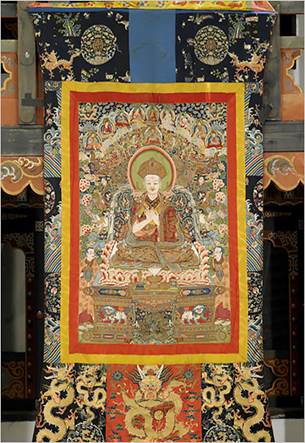
John Johnson, The Coates-Cowden-Brown Curator of Asian Art at the San Antonio Museum of Art was our speaker for the Asian Arts Council Meeting on July 26th. Mr. Johnson’s topic was the Buddhist Art of Bhutan, home to the most intact and vital Buddhist art tradition in the world. Mr. Johnson lived in Bhutan for three years researching Buddhist art for the major international exhibition, “The Dragon’s Gift: The Sacred Arts of Bhutan”, of which he was the co-curator and catalogue co-author. He discussed the development of Buddhist art and the role which Buddhist images play in monastic rituals. [Bhutan; 18th century; Textile]
August 23 - 1:00 p.m. (a week early) Kamisaka Sekka (1866-1942): Rinpa Traditionalist, Modern Designer Andreas Marks, Ph.D.
AAC Newsletter – September 2012, p 2-3 Lecture Flyer
 Dr. Andreas Marks, Director and Chief Curator of the Clark Center for Japanese Art and Culture presented Kamisaka Sekka (1866-1942): Rinpa Traditionalist, Modern Designer.
Dr. Andreas Marks, Director and Chief Curator of the Clark Center for Japanese Art and Culture presented Kamisaka Sekka (1866-1942): Rinpa Traditionalist, Modern Designer.
Kamisaka Sekka was born just before the beginning of the Meiji period (1868-1912), a vibrant time in Japan's history that not only saw the end of a 250-year period of isolation, but also rapid Westernization and modernization of the country.  Sekka became an ardent follower of the Rinpa painting tradition, a decorative style that first originated in the seventeenth century. Often referred to as the "Last Great Rinpa Artist", Sekka would go on to lead the revival of Rinpa in the early twentieth century. His influence goes far beyond mere revival, however, as he was also instrumental in the development of modern design in Japan. A prodigiously creative artist, Sekka not only developed imaginative designs but also co-operated with other artists to apply designs to lacquer ware, textiles, ceramics, and furniture. While deeply rooted in the history and tradition of Japanese art, Sekka was a visionary transitional figure between traditional art forms and the world of modern design and production.
Sekka became an ardent follower of the Rinpa painting tradition, a decorative style that first originated in the seventeenth century. Often referred to as the "Last Great Rinpa Artist", Sekka would go on to lead the revival of Rinpa in the early twentieth century. His influence goes far beyond mere revival, however, as he was also instrumental in the development of modern design in Japan. A prodigiously creative artist, Sekka not only developed imaginative designs but also co-operated with other artists to apply designs to lacquer ware, textiles, ceramics, and furniture. While deeply rooted in the history and tradition of Japanese art, Sekka was a visionary transitional figure between traditional art forms and the world of modern design and production.
Note: Dr. Marks mentioned an excellent exhibit on Rinpa at the Metropolitan Museum of Art, “Designing Nature: The Rinpa Aesthetic in Japanese Art” with an accompanying, informative essay and images of over 100 objects in the exhibit, which can be accessed at www.metmuseum.org
August 25 - 1:00 p.m. (a week early) Farewell Luncheon for Sonya Quintanilla, Asian Arts Curator
Sep. 27 - 1:00 p.m. Islamic India Jim Richter, Docent
AAC Newsletter – October 2012, p 3-5 Lecture Flyer
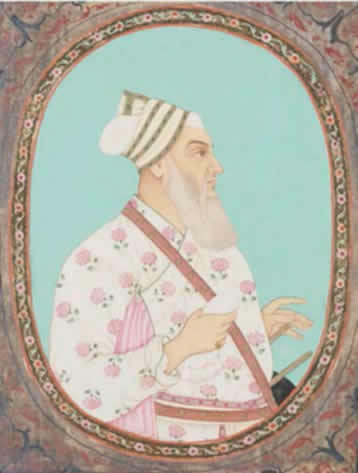 Prof. Kendall H. Brown, Professor of Asian Art History, School of Art, CSU Long Beach offered Delirious Japan: Japanese Art Deco, 1920-1945, illustrating key ideas and objects in an exhibition that is the first to focus solely on Japanese manifestations of the mid-century style now known as Art Deco. The exhibition and accompanying catalogue by Prof. Brown and collaborators in Japan, Britain and Australia, included 197 objects from the Levenson collection in Florida. The exhibit is notable for the high quality of works including paintings, woodblock prints, offset-printed songbooks, silk kimono, metal figurines, lacquer vases, ceramic vessels, and glass plates. These objects were made for four distinct social “spaces” (from high to low): the national art salon or museum, the middle-class home displaying Deco tableware and furnishings, the Western and/or Japanese clothing choices of the bourgeois young lady or gentleman, and the public space of the café and street reflected in posters, sheet music and cigarette boxes.
Japanese art deco style exhibits both cosmopolitan brio and nationalistic fervor, characterized by vivid colors, geometric design (either abstract or nature-based), and sleek but powerful forms. Thus, it is seen in erotic images of the “modern girl,” the Japanese flapper, and such nativist-militaristic icons as the dragon, phoenix, and heavenly lion. The lecture traced internationalism, nationalism and the “cultured home” where eclectic styles were combined to exhibit personal taste.
K. Kotani, The Modern Song (Modan bushi), 1930. Color lithograph, ink on paper, 16 x 20 in
However, the strongest images may well be those that show the modern girl smoking, drinking, and dancing in her familiar milieu of café, cabaret, and dance hall.
/>
Jim Richter, AAC Study Group Member & SDMA Docent Trainee presented a well illustrated and very informative lecture on The Art and Architecture of Islamic India.
Prof. Kendall H. Brown, Professor of Asian Art History, School of Art, CSU Long Beach offered Delirious Japan: Japanese Art Deco, 1920-1945, illustrating key ideas and objects in an exhibition that is the first to focus solely on Japanese manifestations of the mid-century style now known as Art Deco. The exhibition and accompanying catalogue by Prof. Brown and collaborators in Japan, Britain and Australia, included 197 objects from the Levenson collection in Florida. The exhibit is notable for the high quality of works including paintings, woodblock prints, offset-printed songbooks, silk kimono, metal figurines, lacquer vases, ceramic vessels, and glass plates. These objects were made for four distinct social “spaces” (from high to low): the national art salon or museum, the middle-class home displaying Deco tableware and furnishings, the Western and/or Japanese clothing choices of the bourgeois young lady or gentleman, and the public space of the café and street reflected in posters, sheet music and cigarette boxes.
Japanese art deco style exhibits both cosmopolitan brio and nationalistic fervor, characterized by vivid colors, geometric design (either abstract or nature-based), and sleek but powerful forms. Thus, it is seen in erotic images of the “modern girl,” the Japanese flapper, and such nativist-militaristic icons as the dragon, phoenix, and heavenly lion. The lecture traced internationalism, nationalism and the “cultured home” where eclectic styles were combined to exhibit personal taste.
K. Kotani, The Modern Song (Modan bushi), 1930. Color lithograph, ink on paper, 16 x 20 in
However, the strongest images may well be those that show the modern girl smoking, drinking, and dancing in her familiar milieu of café, cabaret, and dance hall.
/>
Jim Richter, AAC Study Group Member & SDMA Docent Trainee presented a well illustrated and very informative lecture on The Art and Architecture of Islamic India.
Islam spread rapidly after its founding by Mohammed in Arabia. The first Islamic invasions of the Indian subcontinent occurred during the 7th and 8th centuries. By the 13th century, the Delhi sultanates controlled large areas in northern India. They were then conquered by the Mughals, who ruled much of India from 1526 until the arrival of the British. The artistic influence of Persian and other Islamic cultures extended throughout India during this long period of Islamic rule.
Islamic architecture was based on the arch. The first sultans built ambitiously throughout the 13th, 14th and 15th centuries in a style influenced by Persian and Central Asian traditions. The use of pointed arches, domes, and vaults are among the most obvious characteristics. Walls were capped with rows of merlons, tooth-like protrusions resembling battlements. Surface decoration imitated Persian designs. Plasterwork was cut in friezes and medallions and filled with stylized arabesque designs, geometric patterns and Persian calligraphy. Paint and tile work in similar designs added bright accents of color. However, Indian motifs were also adopted, in particular, the lotus flower, which appears in endless variations in bands around doors and windows and along the walls, as well as at the summits of domes and vaults.
Islamic architecture includes several differ-ent structural types, divided between the religious and the secular. The religious structures include mosques and tombs. Secular structures include houses, pavilions, town walls and gates, water wells and large palace-forts.
Illustrations in books and small-scale paintings grouped in albums or sets are among the most important art forms produced in India during the Delhi sultanates. Islamic paintings are usually particularized, stressing a specific individual or event. They show an interest in spatial depth, which helps to place a scene in a setting. The colors used are somewhat muted. Through time, and in different provinces, the details varied somewhat. However, the Islamic paintings of this period are (usually) easily distinguishable from Hindu or Jain art.
Oct. 25 - 1:00 p.m. Delirious Japan: Deco in War
and Peace Kendall Brown, Ph.D.
AAC Newsletter – November 2012, p 2 Lecture Flyer
Prof. Kendall H. Brown, Professor of Asian Art History, School of Art, CSU Long Beach offered Delirious Japan: Japanese Art Deco, 1920-1945, illustrating key ideas and objects in an exhibition that is the first to focus solely on Japanese manifestations of the mid-century style now known as Art Deco. 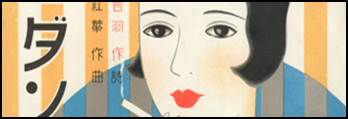 The exhibition and accompanying catalogue by Prof. Brown and collaborators in Japan, Britain and Australia, included 197 objects from the Levenson collection in Florida. The exhibit is notable for the high quality of works including paintings, woodblock prints, offset-printed songbooks, silk kimono, metal figurines, lacquer vases, ceramic vessels, and glass plates. These objects were made for four distinct social “spaces” (from high to low): the national art salon or museum, the middle-class home displaying Deco tableware and furnishings, the Western and/or Japanese clothing choices of the bourgeois young lady or gentleman, and the public space of the café and street reflected in posters, sheet music and cigarette boxes.
The exhibition and accompanying catalogue by Prof. Brown and collaborators in Japan, Britain and Australia, included 197 objects from the Levenson collection in Florida. The exhibit is notable for the high quality of works including paintings, woodblock prints, offset-printed songbooks, silk kimono, metal figurines, lacquer vases, ceramic vessels, and glass plates. These objects were made for four distinct social “spaces” (from high to low): the national art salon or museum, the middle-class home displaying Deco tableware and furnishings, the Western and/or Japanese clothing choices of the bourgeois young lady or gentleman, and the public space of the café and street reflected in posters, sheet music and cigarette boxes.
Japanese art deco style exhibits both cosmopolitan brio and nationalistic fervor, characterized by vivid colors, geometric design (either abstract or nature-based), and sleek but powerful forms. Thus, it is seen in erotic images of the “modern girl,” the Japanese flapper, and such nativist-militaristic icons as the dragon, phoenix, and heavenly lion. The lecture traced internationalism, nationalism and the “cultured home” where eclectic styles were combined to exhibit personal taste. However, the strongest images may well be those that show the modern girl smoking, drinking, and dancing in her familiar milieu of café, cabaret, and dance hall. [K. Kotani, The Modern Song (Modan bushi), 1930. Color lithograph, ink on paper, 16 x 20 in]
Dec. 3 - 11:00 a.m. Heritage Luncheon and Auction
The Heritage Luncheon was held at the Prado for the first time and was a HUGE success!
Jan 31 - 1:00 p.m. Chinese Influence on Japanese Landscape Painting Sonja Simonis, Clark Center
AAC Newsletter – February 2013, p 3 Lecture Flyer
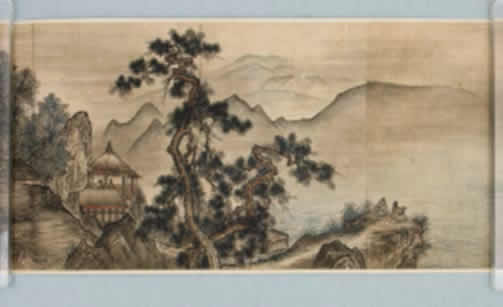 Sonja Simonis, Curatorial Assistant at the Clark Center for Japanese Art and Culture presented The Chinese Influence on Japanese Landscape Painting. China has always played an important role in the development of the arts in Japan, and in this lecture she highlighted the connections between Chinese and Japanese landscape painting throughout the centuries. From the earliest landscape images of the Heian period (794-1185) until the literati paintings of the 18th and 19th centuries, Japanese artists adopted Chinese painting methods, styles, and motifs.
[Landscape by Shügetsu (1440?-1529)]
Sonja Simonis studied History of East Asian Art and Japanese studies at Free University Berlin. The still life images of nihonga painter Takeuchi Seiho (1864-1941) were the subject of her Master's Thesis. Her doctoral dissertation is focusing on the life and works of Japanese ceramicist Kato Takuo (1917-2005).
Sonja Simonis, Curatorial Assistant at the Clark Center for Japanese Art and Culture presented The Chinese Influence on Japanese Landscape Painting. China has always played an important role in the development of the arts in Japan, and in this lecture she highlighted the connections between Chinese and Japanese landscape painting throughout the centuries. From the earliest landscape images of the Heian period (794-1185) until the literati paintings of the 18th and 19th centuries, Japanese artists adopted Chinese painting methods, styles, and motifs.
[Landscape by Shügetsu (1440?-1529)]
Sonja Simonis studied History of East Asian Art and Japanese studies at Free University Berlin. The still life images of nihonga painter Takeuchi Seiho (1864-1941) were the subject of her Master's Thesis. Her doctoral dissertation is focusing on the life and works of Japanese ceramicist Kato Takuo (1917-2005).
Feb. 15 Art of East Asia Opens Sonya Quintanilla, Ph.D., Curator of Asian Art
It was quite the event for the Asian Arts Council members, and a complete change in how the works of art are displayed.
Feb. 28 - 1:00 p.m. Japanese Prints for Books Masato Nishimura, PhD, Associate Curator of
Southern Asian and Islamic Arts
AAC Newsletter – March 2013, p 2 Lecture Flyer
 UCSD Professor Masato Nishimura, Ph.D., presented Japanese Prints for Books at the February meeting, discussing the woodblock prints illustrating early Japanese printed books. These range from the earliest printing of Buddhist sutras in the 8th century to the 19th century, and the illustration of popular literature, travel guidebooks, encyclopedia, art manuals and medical books. The artist’s view of the world provided a glimpse of life during the Edo period (1603 – 1868) when Japan was closed from most outside influences.
UCSD Professor Masato Nishimura, Ph.D., presented Japanese Prints for Books at the February meeting, discussing the woodblock prints illustrating early Japanese printed books. These range from the earliest printing of Buddhist sutras in the 8th century to the 19th century, and the illustration of popular literature, travel guidebooks, encyclopedia, art manuals and medical books. The artist’s view of the world provided a glimpse of life during the Edo period (1603 – 1868) when Japan was closed from most outside influences.
Whereas the Ukiyo-e (large single prints) mostly dealt with the portraits of actors and courtesans, as well as landscape and legends, the book illustration showed the intimate daily life of ordinary people.
The difference between Japanese art and Western art was made apparent in the depiction of reality. Whereas Western art endeavored to present the world as realistically as possible, the Japanese prints presented a different way to view the world. Drawing from the use of brush and ink for writing, line was very important. Although chiaroscuro or the use of shadows implying a source of light was emphasized in Western art, Japanese prints presented a distillation of features and often a bird’s eye view of a scene. Depiction of actual rain falling was convincingly illustrated in woodblock prints whereas showing rainfall in the West was unknown. An innovation developed in the 18th century was to depict the thoughts and words of a person in a print by enclosing in a “balloon” above the head of the person a scene illustrating his/her thoughts as well as words describing them.
As Japan opened to the West in the late 19th century, the mingling of ideas from the two traditions allowed artists as well as the public to view the world with an expanded perspective and appreciation.
Mar. 28 - 1:00 p.m. The Temples of Angkor Jim Richter, Docent
AAC Newsletter – April 2013, p 2 Lecture Flyer
 In March, Jim Richter presented The Temples of Angkor, beautifully illustrated by his photographs of many of the temples. At the height of the Khmer kingdom, the empire extended beyond Cambodia to include present-day South Vietnam, Laos, Thailand and part of Burma. The Hindu religion spread from India to Southeast Asia and was adopted by the Khmer kings who built the Angkor temples during the 9th to the 12th centuries to align with the cardinal compass points. A central tower with smaller towers at the four corners represented Mt. Meru, home of the Hindu gods, while moats within the complex represented the oceans believed to surround Mt. Meru. The construction was of brick, sandstone, or laterite, a soft clay when dug from the ground that hardens when dried in the sun. Interestingly, many woodworking techniques were employed even when working in stone. Detailed carvings in stone or plaster surrounding the doorways depicted stories derived from the Hindu literature of the Ramayana and Mahabharata, or as in the galleries at Angkor Wat, illustrated the battle victories of the Khmer kings. After the defeat of the Khmers in the 15th century, the temples were engulfed by the jungle and forgotten until they were rediscovered in the 19th century by French explorers. Many have been stabilized and some have been rebuilt, a painstaking process that continues today. The distinctive features of each temple that differentiates it from any other were illustrated by Jim’s photographs of 17 of the major temples in the Angkor complex.
In March, Jim Richter presented The Temples of Angkor, beautifully illustrated by his photographs of many of the temples. At the height of the Khmer kingdom, the empire extended beyond Cambodia to include present-day South Vietnam, Laos, Thailand and part of Burma. The Hindu religion spread from India to Southeast Asia and was adopted by the Khmer kings who built the Angkor temples during the 9th to the 12th centuries to align with the cardinal compass points. A central tower with smaller towers at the four corners represented Mt. Meru, home of the Hindu gods, while moats within the complex represented the oceans believed to surround Mt. Meru. The construction was of brick, sandstone, or laterite, a soft clay when dug from the ground that hardens when dried in the sun. Interestingly, many woodworking techniques were employed even when working in stone. Detailed carvings in stone or plaster surrounding the doorways depicted stories derived from the Hindu literature of the Ramayana and Mahabharata, or as in the galleries at Angkor Wat, illustrated the battle victories of the Khmer kings. After the defeat of the Khmers in the 15th century, the temples were engulfed by the jungle and forgotten until they were rediscovered in the 19th century by French explorers. Many have been stabilized and some have been rebuilt, a painstaking process that continues today. The distinctive features of each temple that differentiates it from any other were illustrated by Jim’s photographs of 17 of the major temples in the Angkor complex.
Apr. 18 - 1:00 p.m. Hidden Treasures of Japanese
Art from the Larry Ellison Collection:
Curating "In the Moment" at the Asian Art
Museum of San Francisco Laura W. Allen, PhD
AAC Newsletter – May 2013, p 2 Lecture Flyer
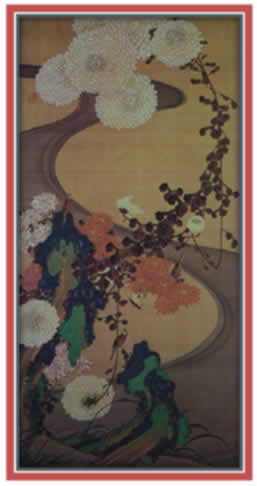 The April lecture by Laura Allen, PhD., provided a glimpse into the special exhibit soon to open at the Asian Art Museum of San Francisco, In the Moment: Japanese Art from the Larry Ellison Collection. She pointed out that his interest in Japanese art was born with his first visit to a Kyoto garden which has led him to assemble an impressive collection of objects, spanning over a thousand years of Japanese history and masterworks in diverse media, including: religious sculpture in wood; painted scrolls and folding screens; lacquered boxes and doors; armor; and an array of vases and small sculptures crafted of metal.
The April lecture by Laura Allen, PhD., provided a glimpse into the special exhibit soon to open at the Asian Art Museum of San Francisco, In the Moment: Japanese Art from the Larry Ellison Collection. She pointed out that his interest in Japanese art was born with his first visit to a Kyoto garden which has led him to assemble an impressive collection of objects, spanning over a thousand years of Japanese history and masterworks in diverse media, including: religious sculpture in wood; painted scrolls and folding screens; lacquered boxes and doors; armor; and an array of vases and small sculptures crafted of metal.
Since most of the artworks are kept at Ellison’s private residence, a Japanese-style home surrounded by a traditional seasonal garden, where only a few visitors have the opportunity to see them, the exhibition will offer the public and scholars a first look at this private collection. Ellison’s habit of rotating objects in temporary displays in his home—a practice based on Japanese social customs—inspired the exhibition’s organization and major themes. Dr. Allen, co-curator of the exhibit, presented a "behind the scenes" look at how the show came together, and at some novel elements of the exhibition's design. [Chrysanthemums by a stream, with rocks, Ito Jakuchu]
May 30 - 1:00 p.m. Quiet Beauty: Japanese Gardens
of North America Kendall Brown, PhD
AAC Newsletter – June 2013, p 2 Lecture Flyer
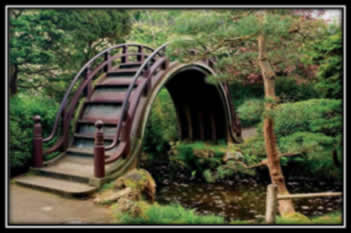 In May Dr. Kendall Brown presented an excellent lecture on Japanese-style gardens in North America, and autographed copies of his newly published book on the subject,
In May Dr. Kendall Brown presented an excellent lecture on Japanese-style gardens in North America, and autographed copies of his newly published book on the subject,
Quiet Beauty: The Japanese Gardens of North America.
Jun. 27 - 1:00 p.m. Chinese Snuff Bottles: Art in Miniature Marsha Vargas Handley
AAC Newsletter – July 2013, p 2 Lecture Flyer
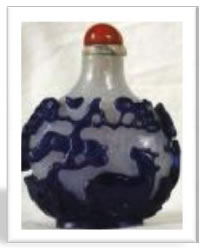 Marsha Vargas Handley, ASA, owner and managing director of Xanadu Gallery in San Francisco, gave a lecture on Chinese Snuff Bottles: Art in Miniature, addressing the origins of the use of snuff in China and the many different materials of which these beautiful little works of art are created.
Marsha Vargas Handley, ASA, owner and managing director of Xanadu Gallery in San Francisco, gave a lecture on Chinese Snuff Bottles: Art in Miniature, addressing the origins of the use of snuff in China and the many different materials of which these beautiful little works of art are created.
[18th century Chinese snuff bottle in glass with cobalt blue overlay depicting an ox and tree. Bequest of Mrs. Inez Grant Parker. 1973.77]

